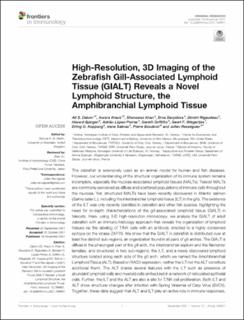| dc.description.abstract | The zebrafish is extensively used as an animal model for human and fish diseases. However, our understanding of the structural organization of its immune system remains incomplete, especially the mucosa-associated lymphoid tissues (MALTs). Teleost MALTs are commonly perceived as diffuse and scattered populations of immune cells throughout the mucosa. Yet, structured MALTs have been recently discovered in Atlantic salmon (Salmo salar L.), including the interbranchial lymphoid tissue (ILT) in the gills. The existence of the ILT was only recently identified in zebrafish and other fish species, highlighting the need for in-depth characterizations of the gill-associated lymphoid tissue (GIALT) in teleosts. Here, using 3-D high-resolution microscopy, we analyze the GIALT of adult zebrafish with an immuno-histology approach that reveals the organization of lymphoid tissues via the labeling of T/NK cells with an antibody directed to a highly conserved epitope on the kinase ZAP70. We show that the GIALT in zebrafish is distributed over at least five distinct sub-regions, an organization found in all pairs of gill arches. The GIALT is diffuse in the pharyngeal part of the gill arch, the interbranchial septum and the filaments/ lamellae, and structured in two sub-regions: the ILT, and a newly discovered lymphoid structure located along each side of the gill arch, which we named the Amphibranchial Lymphoid Tissue (ALT). Based on RAG2 expression, neither the ILT nor the ALT constitute additional thymi. The ALT shares several features with the ILT such as presence of abundant lymphoid cells and myeloid cells embedded in a network of reticulated epithelial cells. Further, the ILT and the ALT are also a site for T/NK cell proliferation. Both ILT and ALT show structural changes after infection with Spring Viraemia of Carp Virus (SVCV). Together, these data suggest that ALT and ILT play an active role in immune responses. Comparative studies show that whereas the ILT seems absent in most neoteleosts (“Percomorphs”), the ALT is widely present in cyprinids, salmonids and neoteleosts, suggesting that it constitutes a conserved tissue involved in the protection of teleosts via the gills. | |
